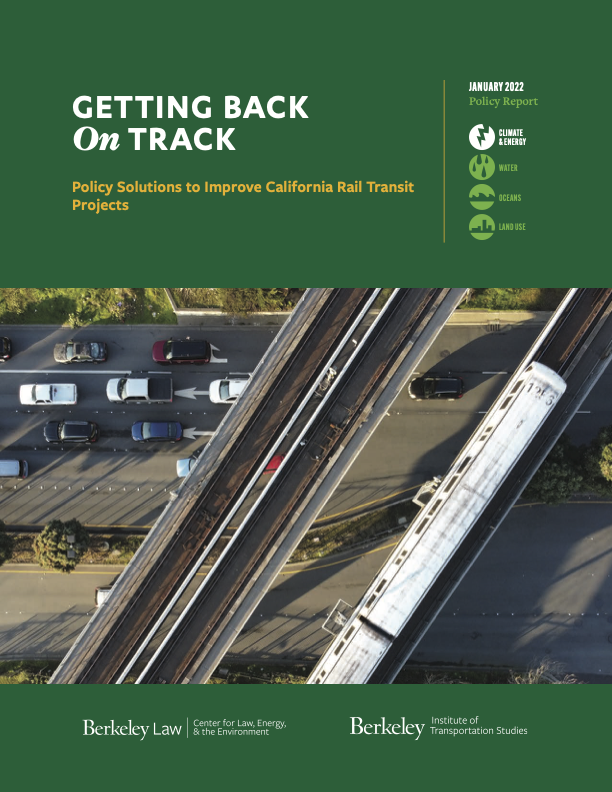
I’m pleased to co-author a new study released today by the Center for Law, Energy and the Environment (CLEE) at UC Berkeley Law that identifies the primary factors underlying cost and schedule overruns for rail transit construction and presents policy recommendations to overcome key barriers.
Improving rail transit delivery is critical for meeting climate and equity goals, given that the transportation sector contributes the majority of the state’s total greenhouse gas emissions. Since the bulk of these emissions come from private automobile travel, rail transit—from heavy-rail subways to overhead-powered trolleys—offers low-emission and low-cost commuting and travel options across income levels.
However, in California and throughout the United States, rail transit infrastructure projects have long suffered from cost overruns and deployment delays that reduce the value of investment and erode public trust. These state and nation-wide projects lag international peers.
For example, completed U.S. heavy rail projects (with trains powered from below via an electric “third rail”) cost more than twice as much on average than their European, Canadian, and Australian counterparts, while U.S. light rail projects (powered by overhead electric lines) cost around 15 percent more than similar projects in Europe, Canada, and Australia. In the United States, different governance authorities hold veto power over multiple decision points, and lack of alignment between these authorities can derail regionally-crucial projects.
Some of the largest and highest-profile California projects, such as the second phase of the Silicon Valley Bay Area Rapid Transit (BART) extension into San José, are particularly slow and expensive. How can California deliver high-quality rail transit projects while keeping on budget and on schedule? Although transit ridership has fallen during the COVID-19 pandemic, ridership is beginning to rebound and transit agencies are committing billions to new infrastructure.
With funding from California SB 1 research dollars through the UC Berkeley Institute of Transportation Studies, CLEE analyzed national and international construction trends and assessed five California rail case studies that offer examples of delivery issues and methods to address them. Common challenges included lack of megaproject management capacity and expertise; project design and scope creep; lack of agency coordination; inefficient procurement and contracting methods; and need for excessive stakeholder outreach.
The five case studies included rail transit projects in Los Angeles, San Diego, San Francisco, and San José, as well as California’s statewide high-speed rail project (which is not a traditional intracity rail line but will be vital to state efforts to reduce vehicle travel). Drawing on the lessons learned from these five cases, CLEE recommends state, regional and local transit leaders consider:
- Forming regional collaboratives to house permanent expertise not tied to any individual local project, with staff available to consult with or contract out to projects when needed. Such a collaborative could benefit projects like the Bay Area Rapid Transit Berryessa Extension, where multi-agency oversight of different project elements required dedicated coordination and communication.
- Creating a statewide office to provide dedicated staff support/ technical assistance to facilitate coordination among local and regional agencies or offer additional funding to agencies that provide detailed plans for addressing any in-house staffing needs, as applicable. For example, the San Francisco Central Subway involved complex construction in a high-density residential and commercial district with significant overruns and delays, in part because agency staff had less megaproject experience than contractor teams. California High-Speed Rail similarly struggled with sufficient in-house capacity, particularly during its early stages.
- Using project procurement and delivery methods that includes early contractor involvement to ensure the total cost of building expensive projects in dense, complex areas is identified before construction begins. For example, the San Diego Mid-Coast Corridor Trolley successfully utilized the construction manager/general contractor or construction manager-at-risk contracting method (CMGC/CMAR), in which the project owner engages a designer and a construction manager separately during the design phase, and the owner and construction manager negotiate a guaranteed maximum price for construction prior to design completion before starting the build phase. This method helped ensure that this relatively pricey project stayed on budget.
- Legislatively granting master permitting authority to transit agencies with priority rail transit projects (including engineering, street closure, and similar project completion-critical permits) to reduce delays and costs imposed by local governments or large or powerful stakeholders along the route. For example, Los Angeles Purple Line Section 1 leaders coordinated with local governments to align expectations about restricted construction times and locations, as local governments held permitting authority over the transit agency.
- Avoiding the addition of significant, non-essential betterments and limiting bespoke design for extraneous station elements (e.g., complex facades), particularly after the design stage. Multiple case study projects suffered from expensive, over-designed project elements to appease stakeholders along the route with effective veto power and other leverage. Determining who will pay for these modifications is a crucial decision point that can push a transit project over budget and behind schedule, if not appropriately managed. State and federal leaders could condition funding on avoiding outcomes that delay a project or place unreasonable cost expectations on the agency and its contractors.
You can read the full report as well as a short policy brief.
Register for a free webinar on Thursday, January 27 at 10:00am Pacific time to learn about the report’s top findings with an expert panel including:
- Hasan Ikhrata, Executive Director of the San Diego Association of Governments (SANDAG)
- Brian Kelly, CEO of the California High-Speed Rail Authority
- Therese McMillan, Executive Director of the Metropolitan Transportation Commission
Thanks to my report co-authors Katie Segal, Ted Lamm and Michael Maroulis.


